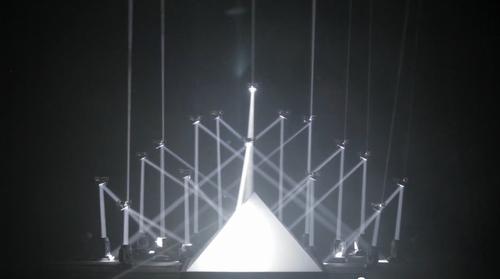Video: Swarming Robots Dazzle Cannes
July 25, 2012

Sixteen of the tiny flying quadrotor robots built by a team at the University of Pennsylvania's General Robotics, Automation, Sensing and Perception (GRASP) Laboratory gave a dazzling sound and light show recently at the Cannes Lions International Festival of Creativity in France. Flying in swarms and equipped with mirrors, they demonstrated their dexterity in a performance at the Saatchi & Saatchi New Directors' Showcase 2012. (You can watch a video of the Cannes performance at the bottom of this post.)
These autonomous, hand-sized acrobats were developed by the electrical engineer Alex Kushleyev and the mechanical engineer Daniel Mellinger, who formed KMel Robotics late last year. In the Cannes show video, the quadrotors dance and manipulate sound and light. On the KMel Robotics Website, credit is given to Vicon for motion capture systems, Analog Devices for MEMS rate gyroscopes, and Murata for accelerometer sensors.

Since we first reported on the quadrotors, more information on them has become available, primarily in the form of videos on the GRASP Lab's site. The longest and most complete video is a TED talk by Vijay Kumar, a professor at Penn's School of Engineering and Applied Science (SEAS) and former head of the GRASP Lab.
The talk gives a wealth of details. For example, the robots weigh between 50gm and 4kg and change motion depending on each rotor's relative speed, which is determined by an onboard processor getting data from onboard sensors and gyroscopes. Kumar also calls the robots alternatives to unmanned aerial vehicles for military applications. They could also be useful in building construction and first responder reconnaissance.
Kushleyev, Mellinger, and Kumar have authored a paper giving further details (PDF). They presented the paper at the Robotics Science and Systems 2012 conference in Sydney.
In our previous story, we hypothesized that the GRASP Lab's participation in the Scalable sWarms of Autonomous Robots and Mobile Sensors (SWARMS) project might explain the lack of details about the quadrotors in earlier announcements. The SWARMS project, associated with the Army Research Office and the Army Institute of Collaborative Biotechnology, posts military-related goals on its Website. It combines robotics, systems engineering, artificial intelligence, control theory, and biology to apply biologically inspired models of swarm behaviors to large networked groups of autonomous vehicles that respond to high-level management commands. The robots could be used for things like rescue missions after natural disasters.
According to Kumar's TED talk, the quadrotors' abilities are clearly related to this project. However, according to a news story on the SEAS Website, KMel does not plan to use its technology for surveillance or military applications. The company designs, builds, and programs customized versions of the quadrotors "for research that will advance algorithms, sensing capabilities, and control mechanisms for group cooperation and autonomous flight."
Related posts:
About the Author(s)
You May Also Like



